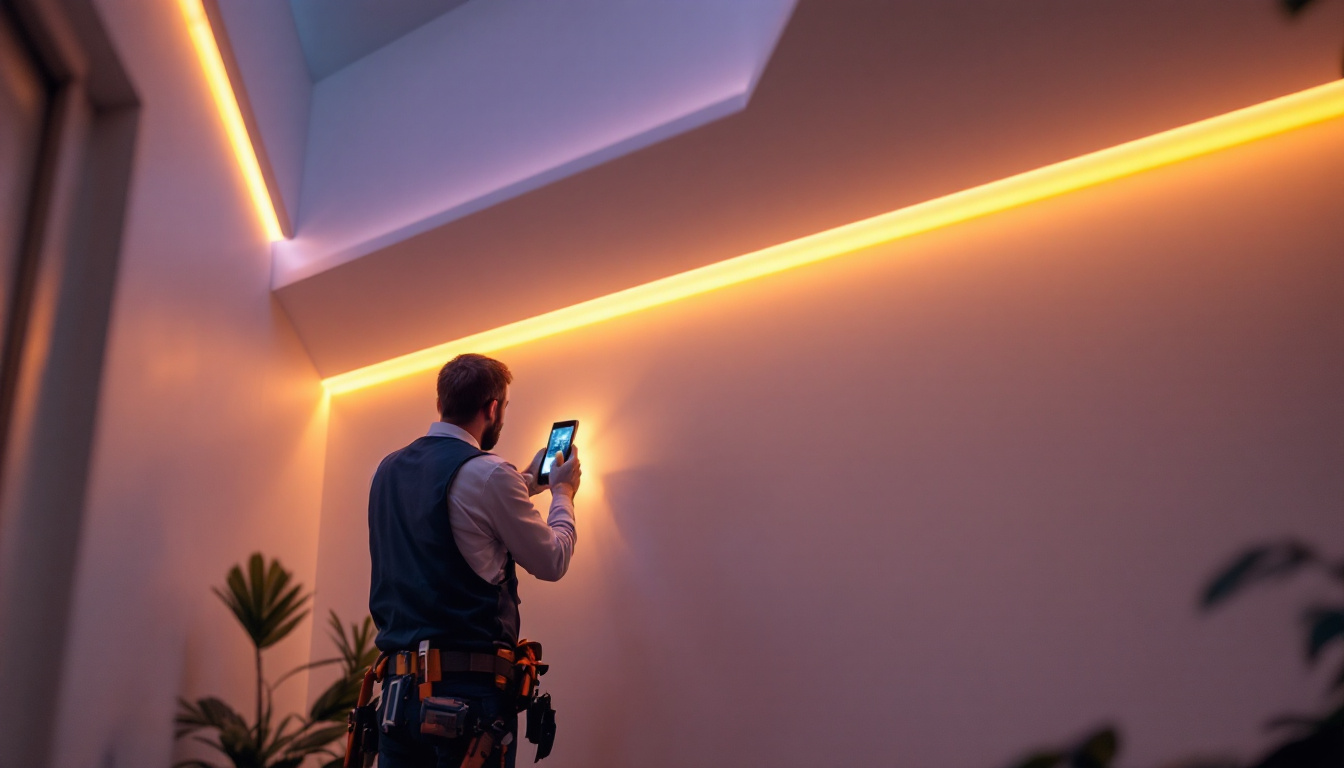
LED cove lighting has become a popular choice among lighting contractors for its versatility, energy efficiency, and aesthetic appeal. However, despite its advantages, there are common pitfalls that can undermine the effectiveness of LED cove installations. This guide aims to highlight these mistakes and provide insights for lighting contractors to ensure successful projects.
Before delving into the mistakes to avoid, it is essential to grasp what LED cove lighting entails. Cove lighting refers to a method of indirect lighting where light fixtures are installed in a recessed area, typically along the perimeter of a ceiling or wall. This technique creates a soft, ambient glow that enhances the overall atmosphere of a space. The subtle illumination provided by cove lighting can effectively highlight architectural features and create a sense of depth, making it a favored choice among designers and homeowners alike.
LEDs are particularly suited for cove lighting due to their compact size, low heat emission, and energy efficiency. They can be used in various applications, from residential settings to commercial spaces, making them a versatile choice for contractors. The flexibility in design allows for creative installations that can adapt to different room shapes and sizes, ensuring that every space can benefit from this innovative lighting solution.
One of the primary reasons for the popularity of LED cove lighting is its numerous benefits. LEDs consume significantly less energy compared to traditional incandescent or fluorescent bulbs, leading to lower energy costs for clients. Additionally, their long lifespan reduces the frequency of replacements, which can be a significant advantage in commercial settings. This longevity not only saves money but also minimizes maintenance disruptions, allowing businesses to maintain a professional appearance without the hassle of frequent lighting changes.
Moreover, LED cove lighting can be integrated with smart home systems, allowing for customizable lighting scenarios that enhance user experience. This adaptability not only adds value to the installation but also showcases the contractor’s expertise in modern lighting solutions. For instance, users can program different lighting moods for various occasions, from a warm, inviting glow for family gatherings to bright, focused lighting for work or study sessions. The ability to control lighting through mobile apps or voice commands further elevates the convenience and sophistication of LED cove lighting, making it an attractive option for tech-savvy homeowners and businesses looking to enhance their environments.
While the advantages of LED cove lighting are clear, several common mistakes can hinder the effectiveness of installations. Awareness of these pitfalls can help contractors deliver high-quality results that meet client expectations.
One of the most significant errors lighting contractors can make is rushing through the planning and design phase. Proper planning is crucial for ensuring that the lighting meets the aesthetic and functional needs of the space. This includes considering the size of the cove, the type of LED fixtures to be used, and the overall design of the room.
Failing to create a detailed lighting plan can lead to uneven lighting, shadows, or overly bright spots, which can detract from the intended ambiance. It is essential to take measurements, assess the room’s layout, and consider the client’s preferences before finalizing the design. Additionally, incorporating software tools for lighting design can help visualize the final outcome and allow for adjustments before installation. This proactive approach can save time and resources, ensuring that the installation meets both aesthetic and functional goals.
The selection of LED fixtures is a critical factor in the success of cove lighting. Not all LED products are created equal, and choosing the wrong fixtures can lead to subpar performance. Contractors should consider factors such as lumen output, color temperature, and beam angle when selecting fixtures.
For instance, using LED strips with insufficient lumen output can result in dim lighting that fails to illuminate the space adequately. Conversely, overly bright fixtures can create glare and discomfort. Understanding the specific requirements of the space will guide contractors in selecting the most suitable LED fixtures. Moreover, it’s wise to explore various fixture designs, such as recessed or surface-mounted options, which can further enhance the overall aesthetic. By evaluating the unique characteristics of each space, contractors can make informed decisions that elevate the quality of the lighting installation.
Color temperature plays a vital role in the overall atmosphere created by cove lighting. Different color temperatures can evoke various moods and feelings within a space. For example, warmer temperatures (around 2700K) create a cozy and inviting ambiance, while cooler temperatures (around 5000K) can promote alertness and focus.
Contractors should engage with clients to determine the desired mood for each space and select LED fixtures that align with those preferences. Neglecting this aspect can result in a lighting scheme that feels disjointed or uninviting. Additionally, it’s essential to consider the color rendering index (CRI) of the LED fixtures, as this will affect how colors appear under the light. A higher CRI ensures that colors look more vibrant and true to life, which is particularly important in spaces like galleries or retail environments where color accuracy is paramount. By thoughtfully addressing color temperature and CRI, contractors can create a harmonious lighting experience that enhances the overall design of the space.
Even with the right planning and product selection, installation challenges can arise. Understanding these potential issues can help contractors navigate the process more smoothly.
One common installation mistake is improper mounting of LED fixtures within the cove. Fixtures should be securely mounted to ensure they remain in place and function correctly. Inadequate mounting can lead to misalignment, which can affect the quality of light output.
Contractors should follow manufacturer guidelines for mounting and ensure that fixtures are level and evenly spaced. This attention to detail will result in a more polished and professional appearance. Additionally, using the right mounting hardware is crucial; for instance, selecting anchors that are appropriate for the wall material can prevent fixtures from loosening over time. Properly installed fixtures not only enhance the aesthetic appeal but also contribute to the longevity of the lighting system.
Wiring is another critical aspect of LED cove lighting installation. Poor wiring practices can lead to flickering lights, inconsistent brightness, or even electrical hazards. It is essential to follow local electrical codes and best practices when wiring LED fixtures.
Contractors should also consider the power supply requirements of the LED fixtures being installed. Using the correct gauge wire and ensuring proper connections will help prevent issues down the line. Taking the time to double-check wiring can save significant headaches in the future. Moreover, it’s advisable to plan the layout of the wiring in advance, mapping out the route to minimize exposure to potential interference from other electrical systems. This foresight can help in avoiding future troubleshooting and ensures a safer installation process.
After installation, it is crucial to test the lighting system before finalizing the project. Many contractors overlook this step, leading to unresolved issues that can frustrate clients. Testing allows for the identification of any problems, such as flickering lights or uneven brightness, that may need to be addressed.
Conducting a thorough test of the lighting system ensures that everything is functioning as intended and provides an opportunity to make adjustments if necessary. This proactive approach enhances client satisfaction and reinforces the contractor’s professionalism. Additionally, it’s beneficial to involve the client during the testing phase, allowing them to see the results firsthand and provide feedback. This collaborative effort not only builds trust but also helps in fine-tuning the lighting to meet the specific ambiance desired by the client, ensuring that the final outcome aligns perfectly with their vision.
Once the installation is complete, ongoing maintenance is essential for preserving the quality and performance of LED cove lighting. Contractors should educate clients about proper maintenance practices to ensure longevity and optimal performance.
Dust and debris can accumulate on LED fixtures over time, diminishing their brightness and overall effectiveness. Contractors should advise clients on how to clean fixtures safely without damaging them. Regular cleaning can help maintain the aesthetic appeal and functionality of the lighting.
Additionally, providing clients with a maintenance schedule can encourage them to keep their lighting systems in top condition. This proactive approach can lead to longer-lasting installations and increased client satisfaction.
Encouraging clients to monitor their lighting systems for any signs of malfunction is another critical aspect of maintenance. Flickering lights, unusual sounds, or inconsistent brightness can indicate underlying issues that need to be addressed promptly.
Contractors should emphasize the importance of reporting any problems immediately. This not only helps maintain the quality of the lighting but also fosters a strong client-contractor relationship based on trust and reliability.
As technology continues to evolve, LED lighting options are constantly improving. Contractors should stay informed about the latest advancements in LED technology and be prepared to recommend upgrades to clients when appropriate.
Upgrading to newer, more efficient LED fixtures can enhance energy savings and improve the overall quality of lighting. Contractors who remain knowledgeable about industry trends can provide valuable insights to clients, positioning themselves as trusted experts in the field.
LED cove lighting offers a wealth of opportunities for lighting contractors to create beautiful, functional spaces. However, avoiding common mistakes is crucial for ensuring successful installations. From proper planning and fixture selection to installation techniques and maintenance practices, attention to detail can make all the difference.
By understanding the potential pitfalls and implementing best practices, contractors can enhance their reputation, improve client satisfaction, and ultimately achieve greater success in their projects. Embracing the nuances of LED cove lighting will not only elevate the quality of installations but also contribute to the ongoing evolution of lighting design.
Ready to elevate your lighting projects with the highest quality LED cove lighting products? Look no further than LumenWholesale. Our commitment to providing spec-grade lighting solutions at wholesale prices ensures that you can deliver exceptional results to your clients without breaking the bank. With free shipping on bulk orders, you can stock up on all the lighting essentials you need, ensuring your installations shine bright and stand the test of time. Don’t let inflated markups dim your project’s potential. Choose LumenWholesale for the perfect combination of quality, affordability, and convenience. Wholesale Lighting at the Best Value is just a click away.

Discover innovative cost-saving strategies for lighting contractors with electronic ballasts.

Explore the advantages and drawbacks of RGB LED lights for lighting contractors.

Discover the advantages and drawbacks of replacing fluorescent tube fixtures with LED lighting from a contractor’s perspective.

Discover how a groundbreaking invention revolutionized safety standards in lighting, surpassing traditional oil lamps.